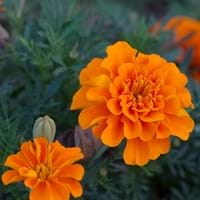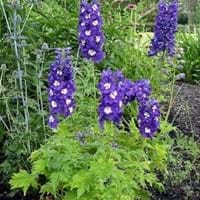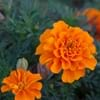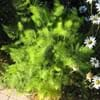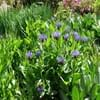Life Span
Annual
Perennial
Type
Flowering Plants, Shrubs
Flowering Plants, Ornamental Plants, Shrubs
Origin
Hybrid origin
Africa
Types
African or American Marigolds, French Marigolds, Mule Marigolds
Not Available
Habitat
Roadsides, wastelands
gardens, meadows
USDA Hardiness Zone
9-11
Not Available
AHS Heat Zone
12-1
12 - 6
Sunset Zone
A1, A2, A3, H1, H2, 1a, 1b, 2a, 2b, 3a, 3b, 4, 5, 6, 7, 8, 9, 10, 11, 12, 13, 14, 15, 16, 17, 18, 19, 20, 21, 22, 23, 24
Not Available
Habit
Upright/Erect
Upright/Erect
Minimum Width
Not Available
Flower Color
Orange, Yellow
Blue, Indigo, Lavender, Light Purple
Flower Color Modifier
Bicolor
Bicolor
Fruit Color
Not Available
Non Fruiting Plant
Leaf Color in Spring
Green
Green
Leaf Color in Summer
Dark Green
Light Green
Leaf Color in Fall
Dark Green
Green, Yellow green
Leaf Color in Winter
Dark Green
Green, Light Yellow, Tan
Leaf Shape
Toothed
Palmate and toothed
Plant Season
Fall, Spring, Summer
Spring, Summer, Fall, Winter
Sunlight
Full Sun, Part sun
Full Sun, Partial Sun
Growth Rate
Very Fast
Slow
Type of Soil
Loamy, Sandy, Well drained
Clay, Loam, Sand
The pH of Soil
Neutral, Slightly Alkaline
Acidic, Neutral, Alkaline
Soil Drainage
Well drained
Well drained
Bloom Time
Early Fall, Early Summer, Fall, Late Fall, Late Summer, Summer
Not Available
Tolerances
Drought
Heat And Humidity
Where to Plant?
Container, Ground, Pot
Ground, Pot
How to Plant?
Seedlings
Seedlings, Stem Cutting
Plant Maintenance
Medium
Medium
Watering Requirements
Allow soil to be completely dry in between waterings, Form a Soil ring to water efficiently, Keep the ground moist but not water-logged, Water in morning to avoid prompting diseases, Water when soil is dry
It cannot sustain wet-feet, Keep ground moist, Requires regular watering, Water more in summer
In Summer
Lots of watering
Lots of watering
In Spring
Moderate
Moderate
In Winter
Average Water
Average Water
Soil pH
Neutral, Slightly Alkaline
Acidic, Neutral, Alkaline
Soil Type
Well drained
Clay, Loam, Sand
Soil Drainage Capacity
Well drained
Well drained
Sun Exposure
Full Sun, Part sun
Full Sun, Partial Sun
Pruning
Prune ocassionally, Remove dead or diseased plant parts, Requires little pruning
Cut away fading foliage, Do not prune during shooting season, Remove damaged leaves, Remove deadheads
Fertilizers
All-Purpose Liquid Fertilizer
High-phosphorous fertilizers used, Organic Flower Fertilizer
Pests and Diseases
Alternaria Leaf Spot, Bacterial leaf spot, Damping-off, Gray mold, Powdery mildew, Root rot
Bacterial leaf spot, fungus, Mealybugs
Plant Tolerance
Drought
Heat And Humidity
Flower Petal Number
Single
Single
Fragrant Bark/Stem
Yes
No
Foliage Texture
Fine
Fine
Foliage Sheen
Matte
Matte
Attracts
Butterflies
Butterflies
Allergy
Asthma, Eye irritation, Red eyes, Runny nose, Throat itching, Watery eyes
Severe allergen, Skin irritation, Skin rash, Throat itching, Vomiting
Aesthetic Uses
Showy Purposes
Beautification, Borders, Showy Purposes, Used for decorating walls, fences, gates, hedges, etc.
Beauty Benefits
Not Available
No Beauty Benefits
Environmental Uses
Air purification
Air purification
Medicinal Uses
Burns, constipation, Inflammation, Upset stomach, Wounds
No Medicinal Use
Part of Plant Used
Flowers, Seeds
Flowers
Other Uses
Can be made into a herbal tea, Decoration Purposes, Used As Food
Used in making blue ink
Used As Indoor Plant
Yes
No
Used As Outdoor Plant
Yes
Yes
Garden Design
Bedding Plant, Edging, Foundation, Houseplant, Mixed Border
Edging, Feature Plant
Botanical Name
TAGETES 'Cottage Red'
Delphinium elatum
Common Name
Marigold
Alpine delphinium, Delphium, Candle larkspur, Siberian larkspur, Musk Larkspur,
In Hindi
गेंदा
अल्पाइन Delphinium
In German
Ringelblume
Alpine Delphinium
In French
Souci
Alpine Delphinium
In Spanish
Caléndula
Alpine Delphinium
In Greek
κατιφές
Alpine Δελφίνιο
In Portuguese
Malmequer
Alpine Delphinium
In Polish
Nogietek
Alpine Delphinium
In Latin
Caltha
Alpine Delphinium
Phylum
Tracheophyta
Tracheophyta
Class
Magnoliopsida
Magnoliopsida
Order
Asterales
Ranunculales
Family
Asteraceae
Ranunculaceae
Clade
Not Available
Angiosperms, Eudicots
Tribe
Not Available
Not Available
Subfamily
Not Available
Not Available
Importance of Marigold and Alpine Delphinium
Want to have the most appropriate plant for your garden? You might want to know the importance of Marigold and Alpine Delphinium. Basically, these two plants vary in many aspects. Compare Marigold and Alpine Delphinium as they differ in many characteristics such as their life, care, benefits, facts, etc. Every gardener must at least have the slightest clue about the plants he wants to plant in his garden. Compare their benefits, which differ in many ways like facts and uses. The medicinal use of Marigold is Burns, constipation, Inflammation, Upset stomach and Wounds whereas of Alpine Delphinium is No Medicinal Use. Marigold has beauty benefits as follows: Not Available while Alpine Delphinium has beauty benefits as follows: Not Available.
Compare Facts of Marigold vs Alpine Delphinium
How to choose the best garden plant for your garden depending upon its facts? Here garden plant comparison will help you to solve this query. Compare the facts of Marigold vs Alpine Delphinium and know which one to choose. As garden plants have benefits and other uses, allergy is also a major drawback of plants for some people. Allergic reactions of Marigold are Asthma, Eye irritation, Red eyes, Runny nose, Throat itching and Watery eyes whereas of Alpine Delphinium have Severe allergen, Skin irritation, Skin rash, Throat itching and Vomiting respectively. Having a fruit bearing plant in your garden can be a plus point of your garden. Marigold has no showy fruits and Alpine Delphinium has no showy fruits. Also Marigold is flowering and Alpine Delphinium is flowering. You can compare Marigold and Alpine Delphinium facts and facts of other plants too.
